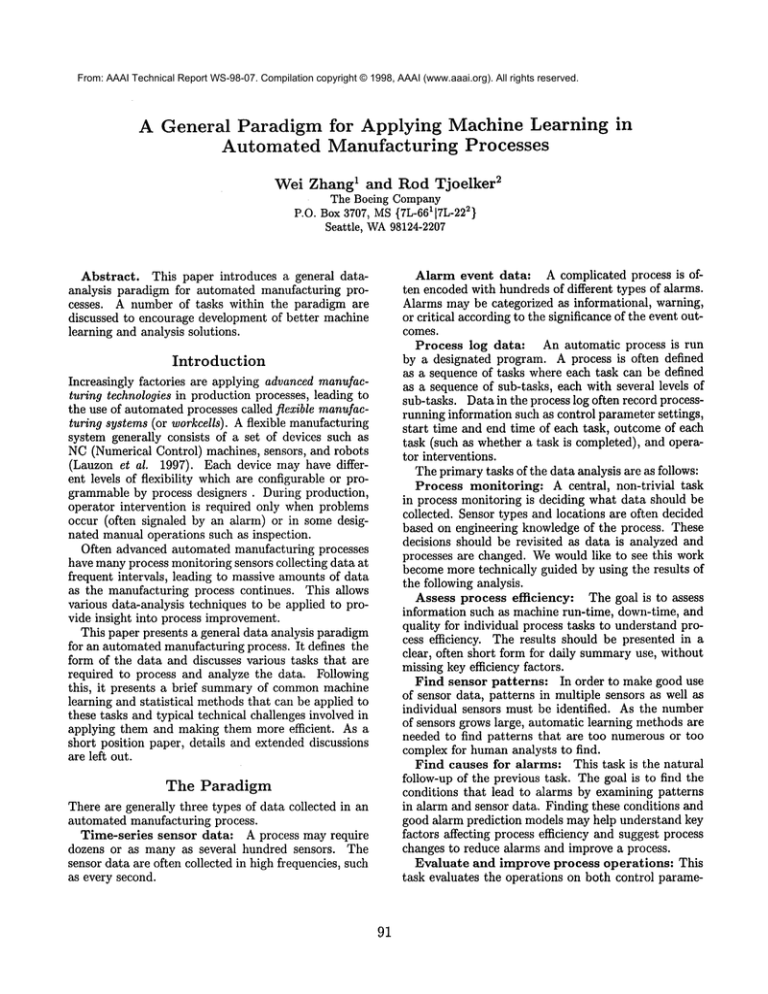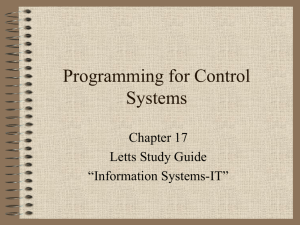
From: AAAI Technical Report WS-98-07. Compilation copyright © 1998, AAAI (www.aaai.org). All rights reserved.
A General Paradigm for Applying Machine Learning
Automated Manufacturing Processes
in
Wei Zhang 1 2and Rod Tjoelker
The Boeing Company
P.O. Box 3707, MS{7L-66117L-222}
Seattle, WA98124-2207
Alarm event data: A complicated process is often encoded with hundreds of different types of alarms.
Alarms may be categorized as informational, warning,
or critical according to the significance of the event outcomes.
Process log data: An automatic process is run
by a designated program. A process is often defined
as a sequence of tasks where each task can be defined
as a sequence of sub-tasks, each with several levels of
sub-tasks. Data in the process log often record processrunning information such as control parameter settings,
start time and end time of each task, outcome of each
task (such as whether a task is completed), and operator interventions.
The primary tasks of the data analysis are as follows:
Process monitoring: A central, non-trivial
task
in process monitoring is deciding what data should be
collected. Sensor types and locations are often decided
based on engineering knowledge of the process. These
decisions should be revisited as data is analyzed and
processes are changed. Wewould like to see this work
becomemore technically guided by using the results of
the following analysis.
Assess process efficiency: The goal is to assess
information such as machine run-time, down-time, and
quality for individual process tasks to understand process efficiency. The results should be presented in a
clear, often short form for daily summaryuse, without
missing key efficiency factors.
Find sensor patterns: In order to make good use
of sensor data, patterns in multiple sensors as well as
individual sensors must be identified. As the number
of sensors grows large, automatic learning methods are
needed to find patterns that are too numerous or too
complex for humananalysts to find.
Find causes for alarms: This task is the natural
follow-up of the previous task. The goal is to find the
conditions that lead to alarms by examining patterns
in alarm and sensor data. Finding these conditions and
good alarm prediction models may help understand key
factors affecting process efficiency and suggest process
changes to reduce alarms and improve a process.
Evaluate and improve process operations: This
task evaluates the operations on both control parame-
Abstract. This paper introduces a general dataanalysis paradigm for automated manufacturing processes. A number of tasks within the paradigm are
discussed to encourage development of better machine
learning and analysis solutions.
Introduction
Increasingly factories are applying advanced manufacturing technologies in production processes, leading to
the use of automated processes called flexible manufacturing systems (or workcells). A flexible manufacturing
system generally consists of a set of devices such as
NC(Numerical Control) machines, sensors, and robots
(Lanzon et al. 1997). Each device may have different levels of flexibility which are configurable or programmable by process designers . During production,
operator intervention is required only when problems
occur (often signaled by an alarm) or in some designated manual operations such as inspection.
Often advanced automated manufacturing processes
have manyprocess monitoring sensors collecting data at
frequent intervals, leading to massive amounts of data
as the manufacturing process continues. This allows
various data-analysis techniques to be applied to provide insight into process improvement.
This paper presents a general data analysis paradigm
for an automated manufacturing process. It defines the
form of the data and discusses various tasks that are
required to process and analyze the data. Following
this, it presents a brief summary of commonmachine
learning and statistical methods that can be applied to
these tasks and typical technical challenges involved in
applying them and making them more efficient.
As a
short position paper, details and extended discussions
are left out.
The
Paradigm
There are generally three types of data collected in an
automated manufacturing process.
Time-series sensor data: A process may require
dozens or as many as several hundred sensors. The
sensor data are often collected in high frequencies, such
as every second.
91
efficiently. Research in this area is still primitive while
various new algorithms are being developed. One interesting algorithm toward this direction is multi-stream
dependency detection (Oates 1996).
Control: The last two tasks involve learning to
better control a process. While statistical process control and design of experiment are often being applied
in factories for process engineers to learn howto run
a process "optimally", the learning curve is often very
slow. Rein]orcement learning is a novel, advanced approach to process optimization (Kaelbling et al. 1996,
Zhang and Dietterich 1995). Based on dynamic programming, this approach learns to evaluate operations
to come up with near-optimal process-running policies
automatically during process execution. Reinforcement
signals are acquired whenever good or bad "responses"
are received and then used to adjust the evaluation of
operations. Learning can be conducted "actively" by
suggesting when an exploratory action can be taken to
find better ways to run a process and when an persistent action has to be used in order to accomplish the
current work--making a good part (this is very importaut during production!). With reinforcement learning,
"off-line" experiments can be largely limited and a potential improvementof process operations can be found
promptly. Furthermore, learning can be conducted for
evaluation on different process configurations. This
helps make a process mucheasier to adapt to changing
requirements. While this approach seems very promising, muchmore practice in real industrial settings will
be required.
In conclusion, advanced automatic learning methods
are required to accomplish the goals of understanding and improvement of automated manufacturing processes. Complex processes generating massive amounts
of data are becoming more commonand more efficient
analysis methods are needed.
ter settings and operator interventions with the goal of
improving them to achieve better product quality and
process efficiency, and reduced cost. Finding an "optimal" way to run a process is desirable. This task requires analysis on existing data to understand current
operations as well as active explorations to fine tune an
existing process.
Adapt a process to changing requirements:
A
process run by a flexible manufacturing system is used
to produce different products or a product under different specifications. This requires that evaluation and
comparison of process operations be conducted across
different process configurations, which will allow a process to adapt to changing requirements. An active exploration is often taken whena new process is initiated.
Solutions
and Issues
The tasks described above are complicated and involve
massive amounts of data. It is not uncommonto collect
several hundred megabytes of data each day. Efficient
automatic or semi-automatic machine learning methods
are essential to complete these tasks.
This section attempts to provide a brief summary
of commonmachine learning and statistical
methods
that can be applied to these tasks and various issues
that make the application challenging. The discussion
is grouped into three categories:
Understanding" The fundamental goal of the data
analysis is process understanding. Various statistical
and machine-learning tools can be applied to understand data. A commonapproach that can be applied
to various tasks above is to develop a set of meaningful features and then apply automatic methods such
as rule induction or decision trees to come up with a
set of rules to explain the relationships (Quinlan 1993,
Breiman et al. 1984). Along this process, tools with
powerful visualization functions are very useful.
However, even with the help of these tools, this understanding process is still very long. The nature of this
work is largely exploratory.
It is a big challenge to speed up the understanding
process! For a given application domain, we believe
there are domain-specific knowledge and methods that
can be acquired or used to help speed up or automate
the understanding process.
Prediction:
Machine learning has achieved the
most progress in developing automatic methods to learn
an accurate model for prediction. These models can be
decision-trees, neural nets, memory-based models, or
stochastic models. Various hybrid models or ensemble
methods are also being developed. These provided a
rich set of choices for the complicated tasks involving
sensor pattern recognition and alarm prediction. One
big challenge is how to determine which is the "right"
method (note, even an experiment using one method
can be very expensive due to the amount of data). Another challenge is to develop methods specific for dependencyanalysis of time-series data with both discrete
and continuous variables so it can be done easily and
References
L. Breiman, J. H. Friedman,
R. Olshen, and
C. J. Stone. Classification
and Regression Trees.
Wadsworth Internatinal
Group, Belmont, CA, 1984.
L. P. Kaelbling, M. L. Littman, and A. W. Moore.
Reinforcement learning: a survey. Journal o] AI Research, 4, 1996.
S.C. Lauzon, J.K. Mills, and b. Benhabib. An implementation methodology for the supervisory control of
flexible manufacturing workcells. Journal o] Manu]acturing Systems, 16(2):91-101, 1997.
T. Oates. Search for structure in multiple streams
of data. In Proceedings of the Thirteenth International Conference on Machine Learning, pages 346354. Morgan Kaufmann, 1996.
R. Quinlan. C~.5: Programs ]or Machine Learning.
Morgan Kaufmann, San Mateo, 1993.
W. Zhang and T. Dietterich. A reinforcement learning
approach to job-shop scheduling. In IJCAI-95, pages
1114-1120, 1995.
92






